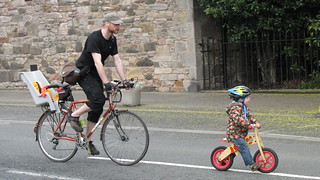Based on a rather surprising thread in another forum.
Which brakes do you use? Obviously it may vary, but in normally slowing down what is your braking technique. I have used 'front & back' but this can include which one you use most.
CityCyclingEdinburgh was launched on the 27th of October 2009 as "an experiment".
IT’S TRUE!
CCE is 16years old!
Well done to ALL posters
It soon became useful and entertaining. There are regular posters, people who add useful info occasionally and plenty more who drop by to watch. That's fine. If you want to add news/comments it's easy to register and become a member.
RULES No personal insults. No swearing.

Based on a rather surprising thread in another forum.
Which brakes do you use? Obviously it may vary, but in normally slowing down what is your braking technique. I have used 'front & back' but this can include which one you use most.
Front on-road, back off-road.
Mostly front unless I need more stopping power. In fact, my rear pads are worn out so are pretty ineffective until I get the new ones on.
I differ depending on which bike (well wheels actualy) I'm using and whether the weather is rainy or not.
Recumbent - Discs FRONT mainly as I've been told they can do 'handbrake turns' very easily.
Dawes with Dynamo - Rear as the front dynamo was expensive to build and I'd rather wear the rims away on my much cheeper Shimano 500 hubbed wheel.
Cotic, - (was discs front and back but now just disc front and cantilever rear) front as the rear is pants, through I've just binned the rear Tektro Lyra and instaled Cantilever brakes with soft pads on the back.
Also if its dry I'm happy to front bias my braking but if its wet I tend to use both, with slightly more bias on the rear.
I'm sure this has been discussed here before but my Google-Fu fails me.
Sheldon, naturally, has an opinion.
I'm for both, which is probably wrong, yet allows for the variety of bikes I ride.
Robert
It's such an automatic action I don't even think about it but as I have to change both front and back brake blocks and rims I'm guessing the answer is both.
Well that's a surprise. I thought best practice was back then front. Having gone over handlebars as a kid, I could never pull the front brake on its own.
Front to slow normally. Front and Back to SLOWWWW NOW.
On icy winter roads/paths this practice needs to be reversed. Back to slow normally, and combination of either Front, or Front and Back when you fancy a lie down.
I thought best practice was back then front.
Yep, especially at speed or descending a hill!
I go for front mainly but do modulate the brakes - I find going for a right-turn downhill indicating, and hence with left only brake can sometimes be tricky - that's when you discover how true your rims are.... (assuming you've got rim brakes)
Both, depending on terrain, turning, weather, speed, etc. The mass distribution and position of fulcra on my main bike makes it impossible to be at risk of going over my handlebars in a normal seated riding position, thereby making it easily possible to get front-wheel lock, which I like to avoid as you can't guarantee that the need to stop will always occur when going straight ahead while perfectly balanced on a road with no approaching ironwork or craters. If I usually use both then I ensure that both are always working properly so that if I snap a cable I'm not suddenly compelled to scrape myself to a halt with my feet.
Generally, the least squeaky of the two.
My back wheel locked today going over a massive diesel spill all along Dundee St.
Both, usually starting with the front before applying the back.
However, in an emergency it's always a case of grab as big a handful of both together as I can!
Front only, if dry and it's a planned stop.
Rear only, if cornering or it's wet, but gently.
Straight line emergency stop >>> handfuls of both! (rear will lock)
Emergency stop when cornering in wet weather >>> hope there isn't a queue in A&E.
*edit* above applies to road bike only.
Front mostly because it's stronger. Dragging the back brake to slow tends to wear the rim out. However I would use the back if I'm not going in a straight line or the road is slippery. In an emergency it's all instinctive - both probably.
I think that I generally try to brake equally, but my rear brake pad does seem to wear quicker, needing to be replaced a year and a half ago whereas the front is still going ok from being new just over five years ago.
I look forward to upgrading to a bike with hydraulic disc brakes, compared to mechanical disc brakes on my current bike, assuming of course that their advertised self-adjusting capacity does indeed work... Whilst I do like the feel of disc brakes, it is relatively rare that I have managed to have them run quietly for long!
"...but my rear brake pad does seem to wear quicker..."
I seem to accumulate vastly greater quantities of road-derived grinding-paste on my rear wheel compared to the front, which knackers any sort of comparison in the wear-time with the front brake.
Both, always. But I anticipate my braking needs and potential conflict situations well in advance, (b) I ride a bike with frankly not very powerful brakes, and (c) I go fairly slowly anyway.
Mostly front. The Surly skids when I use the back which is quite motivational.
On a road if your back brake makes a difference you're not trying hard enough with the front one.
Sometimes my back brakes have got a bit seized from lack of use so I try to use them every few weeks.
For a long time I only had front brakes.
" On a road if your back brake makes a difference you're not trying hard enough with the front one."
Or you're trying to avoid a front-wheel skid on an inclement surface or trying to distribute rim wear.
Must fish out that braking thread from a few months back where there was a similar "Back brakes? PAH!" undercurrent.
Yes, on ice or grit I use the back. I've very rarely on grit, or anything that's not tarmac, and if the ice is bad I use a trike which only has front brakes.
I don't understand why you would try to distribute the wear.
So that you increase the chance of the rear rim being the one which fails, rather than the front, which would probably be a bit nastier if it happened when moving? So that your perfectly-true-for-thirty-months front wheel lasts a bit longer, whereas the problem-haunted rear would probably suffer terminal something else terminal long before the rim is worn through?
But eventually your front rim will wear out and could fail. I don't see how wearing out the back stops the front from wearing out it just changes the time required. I check them for wear.
I'm not troubled with wheels going out of true. Outwith odd catastrophic failure from holes in the road I wear out the rims. I don't need to take them back to Big Al for tweaks in-between rim replacements.
Brompton front rims usually last a couple of years.
My trike still has its original 1995 back rims on it. The front was replaced after it hit the Arran car ferry in '96.
Road bike has 1990 wheels which still work but it actually uses some 2001 wheels.
I don't remember replacing a Brompton rear rim apart from the one which went from Baillieston to Springburn on a flat tyre after a Brompton Green sidewall blew out. I couldn't mend the tyre and I had to get to work.
It's interesting that people put this much thought into it. I started a reply detailing my braking strategy then I thought "hmm, I'm not actually sure I do what I say I do, because I can't visualise braking on the bike at all".
I *think* I use the front only, unless for some reason I use the other one, like going down a long steep descent, or it's slippy or whatever.
I'm not sure I'd use both, unless I was just flailing in a crisis.
I am a rogue element in this survey since two of my bikes only have a front lever, but are in one sense always using the back brake. In terms of deliberate speed reduction I use the back brake with much more frequency than the front; over and above the silence, weatherproof nature and lack of rim/disc/pad wear, that Zen hippie guff just makes it a nicer way to slow down.
On the other two: Both. I'm satisfied with the physics of the argument presented by Uncle Sheldon, but using both just feels nicer.
I don't put any more thought into it when doing it beyond normal background not-wanting-to-fall-off-or-crash, but when threads pop up with people getting all "not trying hard enough" or "flailing" about the rear brake I feel compelled to show some working.
I have a great deal of difficulty remembering which hand operates which brake, so I've no idea which I use most. Probably whichever is currently working most effectively / squeaking the least / is operated by the hand I'm not signalling with. If I need to stop NOW then both, obviously.
EDIT - reading through this thread again, I see even using both for an emergency stop is not obvious. I think I will retire confused from this thread as clearly I've no idea how to ride a bike...
^ Yes, thank goodness you weren't trying to organize a BoP
You must log in to post.

 Cycling in Edinburgh Flickr group
Cycling in Edinburgh Flickr group
Video embedded using Easy Video Embed plugin